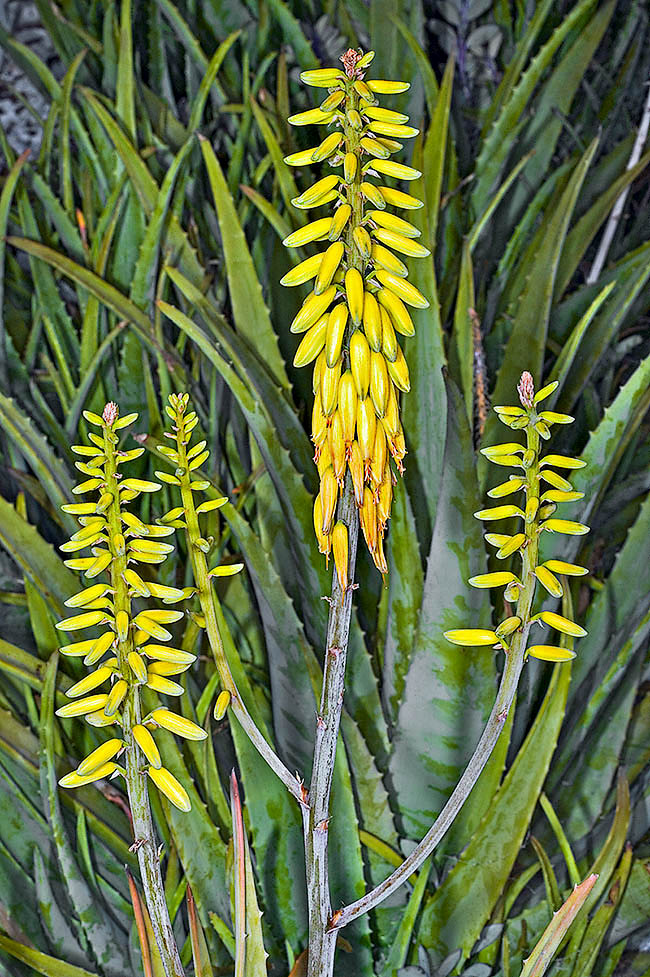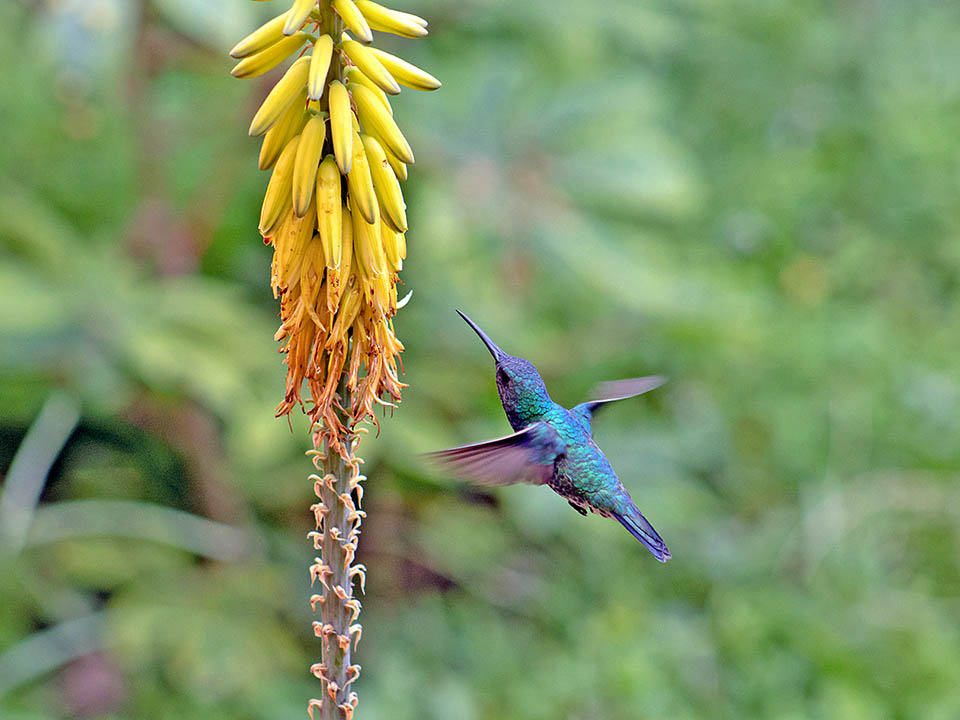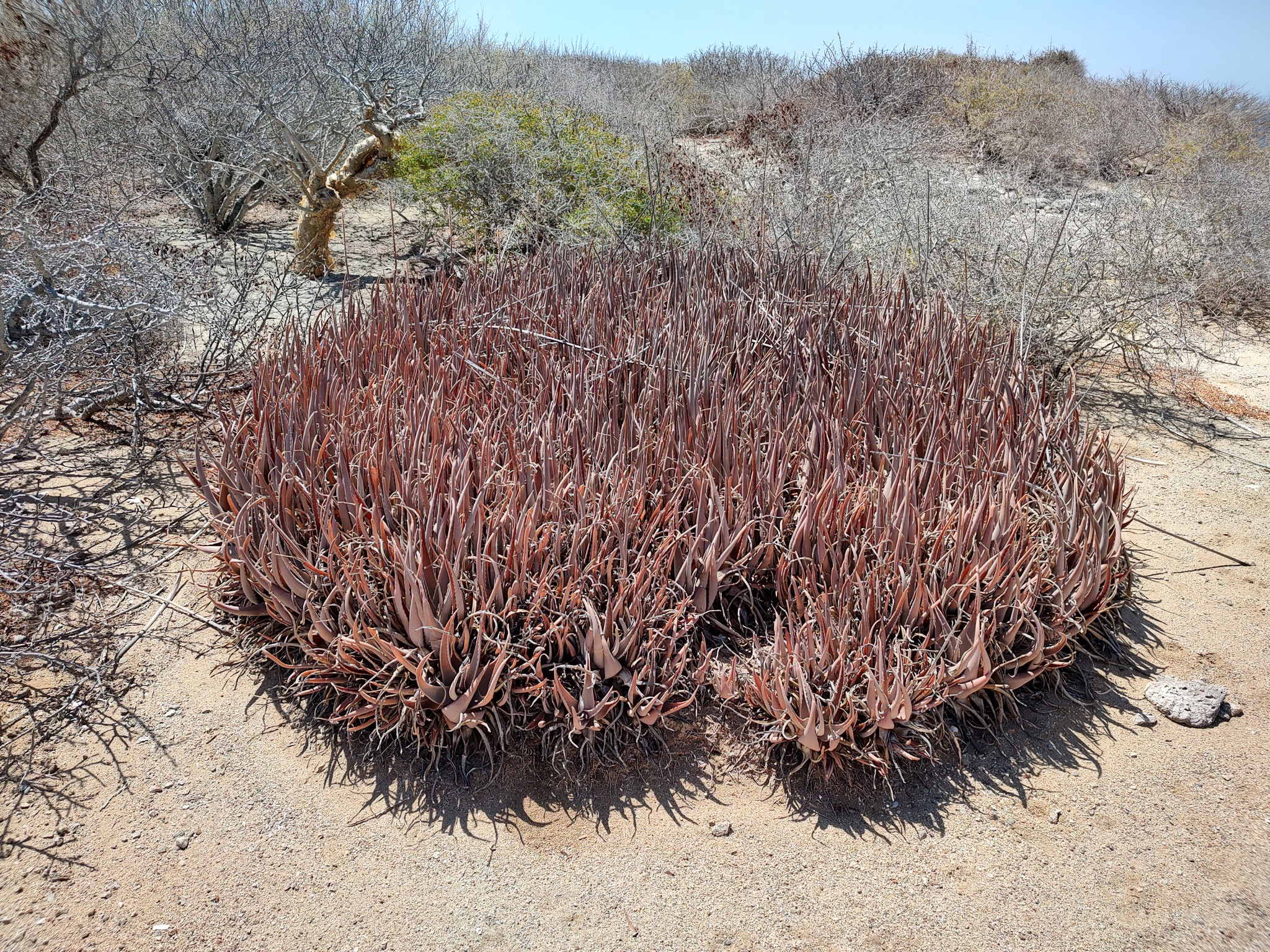Family : Asphodelaceae

Text © Prof. Pietro Pavone

English translation by Mario Beltramini

Native to desert territories, Aloe vera probably comes from Arabian Peninsula or north-eastern Africa © Giuseppe Mazza
Aloe vera (L.) Burm.f. is a species assigned to the family Asphodelaceae that includes monocotyledonous plants of the warm and temperate regions of Europe, Asia, Africa and Oceania.
According to the classification aPG IV of 2016, the family Asphodelaceae is subdivided in three subfamilies: Asphodeloideae, Hemerocallidoideae and Xanthorrhoeoideae. Aloe vera belongs to the subfamily
Asphodeloideae whilst traditionally it was included in the family Liliacea or Aloeaceae. The genus Aloe counts about 500 species. The number of species has decreased compared to the past because, after phylogenetic studies, several species of Aloe have been segregated into other genera among which Aloidendron with Aloidendron pillansii, Aloiampelos, Aristaloe, Gonialoe and Kumara.
It was described for the first time in 1753 by Carl Linnaeus (1707-1778) as Aloe perfoliata var. vera L. (Sp. Pl.: 320, 1753), but a few years later, in 1768, Nicolaas Laurens Burman (1734-1793), his pupil, elevated it to the rank of species with the name of Aloe vera (L.) Burm.f. (Fl. Indica: 83, 1768). In the same year Philip Miller (1691-1771) assigned to it the name of Aloe barbadensis Mill. (Gard. Dict., ed. 8.: n.° 2 (1768) but nowadays this name is considered synonymous with the name given by Burman even if it still appears in many medicinal citations.

It may be 1 m tall with ramified inflorescences. The succulent leaves arranged in rosette weigh even 1 kg © Giuseppe Mazza
Aloe vera is native to the desert territories probably of the Arabian Peninsula or of north-eastern Africa. Recent research, with techniques based on the DNA comparison, made clear that Aloe vera, is strictly related to the Aloe perryi Baker, a species endemic to Yemen, to Aloe forbesii Balf. f., endemic to Socotra and to Aloe inermis Forssk. of the Arabian Peninsula. Various field surveys of these vast territories indicated that it is naturally more abundant in the wadies of the northern mountains of Oman (Ghazanfar, S.A. – Scripta Botanica Belgica 2: 1-153, 1992).
Vulgarly this species is known as Barbados aloe, Aloe amara, Curaçao aloe, Yellow flower aloe. In the Hindi (India) language it is called Ghrit kumari. The etymology of the Latin name traces back to Plyny (maybe from the Greek ἅλς, ἁλός háls, halós sea, salt or from Arabic aluat, bitter thing, due to its very bitter juice). The specific name comes from Latin verus with the meaning of genuine, real, true, in contrast to other species with similar but less valuable properties.
Aloe vera is a plant with short stems that may be 60-100 centimetres tall. The leaves, glaucous-green in colour, persistent, succulent, triangular-pointed, canaliculate and curved, 30-50 (60) cm long and up to 8 (10) cm broad at the base. They are arranged, numerous, in a terminal dense rosette and may present white or pinkish spots on the upper and lower pagina and everyone can weigh even more than one kilo.
The foliar margin is serrated with white or pinkish sharp thorns.
In cross-section the leaf is composed mainly by three layers. In the outer layer are present cells having a thick wall covered by a cuticle having protective function, under which stand cells containing chloroplasts (chlorenchyma). The middle layer presents the vascular bundles responsible for the transportation of water (xylem) and sugars (phloem) and contains laticiferous vessels in charge of transporting the latex, yellow-ochre, of bitter taste, rich in aloin the plant produces to defend itself from animals.
The latex, if dried in the sun, is called “aloe hepatic” and appears as an opaque and crumbly mass whilst, if obtained by boiling, is called “shiny aloe”, almost black, and has a glassy and translucent consistency.
The inner part of the leaf is composed of big parenchymatous cells with thin walls that store a transparent mucilaginous gel that serves as water and energy reserve for the plant. In fact, it contains 99% of water and is composed of glucomannans, amino acids, lipids and vitamins.
The roots of Aloe vera, like those of other species of Aloe, are in symbiosis with fungi and form particular structures, called arbuscules, inside the cells of the root, necessary for the exchange of nutrients. In fact, the “arbuscular mycorrhizae” help the plant to absorb the phosphorus and other mineral nutrients from the ground while the plant furnishes to the fungal mycelium sugars obtained from the process of photosynthesis.

The 2-3 cm flowers, merged in hanging racemes are formed by 6 tepals merged in a bright yellow tubular structure © Giuseppe Mazza
The floriferous stem, usually ramified, can rise up to 60-90 cm over the leaves. The fruits organized in racemes, are pendulous, 2-3 cm long, formed by six tepals merged in a tubular structure (perigonium) of bright yellow colour. The red flowers can be found in the cultivars. The ovary is superior. The stamens and the stigma, at maturity, slightly protrude the perigonium. The maturation of the pollen happens before the receptivity of the stigma (proterandrous flowers), this prevents self-pollination, therefore pollinators are necessary that, in the places of origin, are birds having a long beak that feed on nectar, known as nectarivorous (Nectariniidae). At times the flowers may be pollinated by the insects. In the USA the ponnation is made by birds having long beaks like the hummingbirds. The state of maturation is gradual and goes from bottom to top.
Flowering usually occurs from spring to autumn, but in some zones the plant can flower between winter and spring.
The fruits ripen after 60-67 days from the flowering, usually in summer and are greenish ovate capsulae that, when mature, are of brown colour, do open releasing numerous seeds.
Aloe vera reproduces by seed or multiplies by separation of the suckers in spring or in early summer. It may be susceptible to scale insects and mealybugs but is usually free from diseases.
The chromosome number is 2n = 2x = 14 (6sm + 6st + 2stsat).
Aloe vera is a plant that has been known and utilized since centuries for its countless health properties that have given it various nicknames.
The first testimonies are in Egypt, where on the well of a Temple, dating 4300 BC, have been found drawings of this plant with illustrations about its use.
Sumerian clay tablets dated 2100 BC tell about its medicinal properties as laxative. The Ebers Papyrus, Egyptian papyrus written around 1550 BC describes in detail the use of Aloe vera mentioning as many as twelve therapeutic uses both for internal and external problems. Composition of the balms was also utilized for embalming the body of the Pharaohs and for this reason it was called “sacred plant of immortality”.
The Egyptian queen Nefertiti (1370 BC ca. – 1330 BC ca.), of the XVIII dynasty, for enhancing the beauty and the skin colour, immersed herself in the donkey’s milk with the addition of juice of Aloe vera. Also Cleopatra (70/69 BC – 30 BC), several centuries later, used its juice as eyewash.
The ancient Greeks used the plant for its healing properties, applying it on wounds, burns and skin diseases.
Hippocrates (460 BC ca. – 377 BC) has described the anti-inflammatory and regenerating effects capable of stopping hair loss and of providing relief from stomach and intestinal pains.
Aloe vera is mentioned also in the Bible in various instances, as well as in the gospel according to John (19:39), where Nicodemus uses a mixture of myrrh and aloe to embalm Jesus’ body, following the Jewish tradition.

The pollination is entrusted to insects and long-beaked birds like the nectarines or the hummingbirds in the USA, where the species was introduced © Lente de oso
In ancient Rome it was used as an external remedy for wounds and burns. Pliny the Elder (23-79), in “Naturalis historia” describes Aloe vera for its therapeutic uses, mentioning its healing properties and the treatment of wounds, stomach problems, constipation and insect bites.
Dioscorides Pedanius (40 ca. – 90 ca.), physician and pharmacologist, lived during the time of Nero, considers it as a universal remedy in the “De Materia Medica” as is mentioned by the manuscript “Codex Aniciae Julianae (Vienna Dioscurides), dated around the 512 AD and honoured to Anicia Juliana, daughter of the emperor Flavius Anicius Olybrius of the Western Roman Empire.
In China, during the Song dynasty, from 960 to 1279, it was used as an integral part of the medical treatments for fever, sinusitis and dermatological disorders.
At the time of Marco Polo’s (1254-1324) travels, it was considered by the Chinese as a “harmony remedy”.
For the monks of the Middle Ages it was a “miracle plant”.

The fruits are ovate greenish capsules, brown when ripe, freeing upon opening numerous seeds © Mike Ross
In the Middle Ages the curative properties of Aloe vera were quite diffused in Europe, where it arrived around 1000-1300, and was used to treat skin problems, digestive disorders and inflammations.
In the fifteenth century the plant was even part of Christopher Colmbus’ expeditions and for these virtues it was introduced in America.
In the 17th century, Aloe vera was further spread throughout the world especially by the Dutch settlers who from Africa exported it to all continents and already in the early 1800s it was utilized as laxative in the USA. For theSeminole Indians of Florida it was “source of youth” because they attributed it rejuvenating properties and used it for the weaning of children.
In the contemporary traditional culture Aloe vera is widely used in China, India, Caribbean and Japan.
The first scientific study on this plant was done in 1851, thanks to which the English researchers Smith and Stenhouse were able to identify the active ingredient, called by them “aloin”, responsible for the extraordinary medicinal effects.
However, only at the beginning of the last century Aloe vera became the subject of in-depth scientific studies. In fact, in 1935, two American physicians of Maryland, Creston Collins and his father did publish a scientific opus on the American Journal of Roentgen (33, 396-397) concerning the use of the fresh leaf of Aloe vera for the treatment of a serious dermatitis a young 31 years old woman had developed on the forehead after an X-ray hair removal treatment. The two researchers saw that after twenty four hours, the itching and burning had subsided and after the following five weeks the patient displayed a complete regeneration of the forehead skin and of the scalp, hair regrowth and complete restoration of the sensitivity.
The first analyses aimed at understanding the phytochemical contents were performed in 1940 by Prof. Tom D. Rowe, of Virginia UNiversity, together with Dr. Lloyd M. Parks of Wisconsin University.
In 1959 it was the turn of the American Health Ministry that definitely documented and testified the evident regenerative capacity of the skin tissues offered by the aloe gel.
After these dates, a lot of research has been done both for identifying all chemical elements of Aloe vera and for testing their action in vivo and in vitro.
In Aloe vera have been found more than 200 bioactive chemical substances like vitamins, enzymes, minerals, sugars, salicylic acids, amino acids and lignin.

In arid sites absence of water and sun stimulate plant to produce anthcyanins, red pigments that absorb sun light reducing the UV radiations damages – no rights reserved – Walter Fertig
Among the vitamins present in the juice we find: vitamin A (beta-carotene), B1 (thiamine), B2 (riboflavin), B3 (niacin), B6 (pyridoxine), B9 (folic acid), B12 (cyanocobalamin), C (ascorbic acid), E (tocopherol).
Among the enzymes we find: alliinase, alkaline phosphatase, bradykinin, carboxypeptidase, catalase, cellulase, lipase and peroxidase. The bradykinase helps in reducing the inflammation if locally applied on the skin.
Among the minerals are present: chromium, iron, phosphorus, magnesium, manganese, potassium, copper, selenium, sodium, zinc. These are elements necessary for the good functioning of the enzyme systems in different metabolic pathways. Are present sugars: monosaccharides (glucose and fructose) and complex polysaccharides like acemannan or acetylated mannan. The mannose-6-phosphate is the most important monosaccharide. They are found in the mucilaginous layer of the leaf and are known as mucopolysaccharidoses. When ingested they form a protective film on the mucous membrane of the gastrointestinal tract reducing the inflammations such as gastritis and colitis.
The mucilaginous layer also contains salicylic acid with anti-inflammatory and antibacterial properties, lignin and saponins; these last are soapy substances having cleansing and antiseptic properties.

Appreciated since old times for the medicinal virtues, in fact Aloe vera is grown in many locations, where the tropical or warm temperate climate allow © Giuseppe Mazza
The latex tubes produce anthraquinones whose main are: aloin A (barbaloin) and aloin B (isobarbaloin), aloe emodin, aloresin A and aloresin B.
They are substances that stimulate the intestinal peristalsis, thus acting as laxatives. The aloin can also cause abdominal cramps and diarrhoea and the latex of aloe is not considered safe for the children or the pregnant breastfeeding persons. If prolonged, the ingestion of latex may cause a number of potential adverse effects, with kidney and heart damage.
The anthraquinones, aloin and aloe emodin, act as analgesics, antibacterials and antivirals.
For external use, from the juice they prepare lotions, gels, soaps and cosmetic products to apply on the skin as a topical medicine.
Among the fatty acids we find 4 sterols: cholesterol, campesterol, β-sitosterol and luteol having an anti-inflammatory action. The luteol also has antiseptic and analgesic properties.
The hormones auxins and gibberellins promote healing of the wounds and have an anti-inflammatory action.

The outer leaves, bigger, are hand-picked 2-3 times per year © Giuseppe Mazza
Aloe vera also produces twenty amino acids of which nine are essential because the human organism is unable to produce them: isoleucine, leucine, lysine, methionine, phenylalanine, threonine, tryptophan, valine, histidine.
Aloe vera in addition to soothing the skin lesions, helps in slowing down the appearance of the wrinkles and in actively repairing the damaged skin cells that display the signs of aging. It is also a powerful detoxifier, antiseptic and tonic for the nervous system and has immunostimulatory and antiviral properties.
In recent years, Aloe vera, among all species of the genus, is the most utilized and known in the world, mainly due to the high yield of its leaves, their robustness and their easy transformation in pulp to drink or gel for external use.
However, the whole leaf extract of Aloe vera not decolorized and ingested orally has been inserted by the Office of Environmental Health Hazard Assessment of California (OEHHA) among the chemical substances that may cause cancer or reproductive toxicity.
Also the International Agency for Research on Cancer (IARC), since 2016 has classified the extract of whole leaves as possible human carcinogen and consequently classified as “carcinogenic group 2B”.
From March 18th, 2021 the European Commission, with its Reg. UE 2021/468 has forbidden the use of food supplements where anthraquinone derivatives (hydroxyanthracenes) are found.
The Commission has not banned all the products based on Aloe, but only those containing hydroxyanthracenes located in the outermost part of the leaf (aloe emodin, emodin, aloin A, aloin B) present in the total extract, as they may cause damage to the DNA with the risk of being genotoxic and carcinogenic.
Despite the numerous scientific studies done on the matter, there are still no certain and reliable indications if the Aloe vera based compounds can prevent or cure cancer in humans.
Aloe vera is widely grown for the production of products in gel and of fresh leaves.
The main growing locations are in the USA (Texas), in Australia, Cuba, Dominican Republic, China, Mexico, India, Jamaica, Kenya, Tanzania, South Africa, Spain and Italy (Sicily, Sardinia and Puglia).
Due to its natural resistance to many parasites and diseases, and not requiring pesticides, the crops are almost all organic.
The largest external leaves are picked up by hand, letting the plant continue to grow and to produce other leaves for the future collections. Usually the collections may be done two or even three times a year. The leaf processing can be manual or mechanical.
Aloe vera commercially is presented as a food or cosmetic gel, juice, vials, capsules.

Leaf tip broken to show the abundant liquid marketed as a food or cosmetic gel, juice, vials and capsules © Giuseppe Mazza
Recently new research is being carried out in order to better understand the intilate mechanisms of adaptation to drought of Aloe vera and, usually of all species of the genus, to select, in the near future, plants suitable for life on a warmer planet due to the climate changes.
Aloe vera is also a plant cultivated as ornamental being ideal for rocky gardens and for those with low water availability. It can be grown in pot, preferably of terracotta with a cactus soil or other of good quality with addition of fine sand or gravel in order to improve the drainage. The plant is to be always placed in full light and with good ventilation. It fears the cold therefore in winter, in the regions with rigid climate, it is to be kept indoors or in a warmed up greenhouse.
Synonyms
Aloe perfoliata var. vera L.; Aloe barbadensis Mill.; Aloe barbadensis var. chinensis Haw.; Aloe chinensis Loudon; Aloe elongata Murray; Aloe flava Pers.; Aloe indica Royle; Aloe lanzae Tod.; Aloe littoralis J.Koenig ex Baker; Aloe maculata Forssk.; Aloe perfoliata var. barbadensis (Mill.); Aloe rubescens DC.; Aloe variegata Forssk.; Aloe vera var. chinensis (Loudon) Baker; Aloe vera var. lanzae Baker; Aloe vera var. littoralis J.Koenig ex Baker; Aloe vulgaris Lam.
